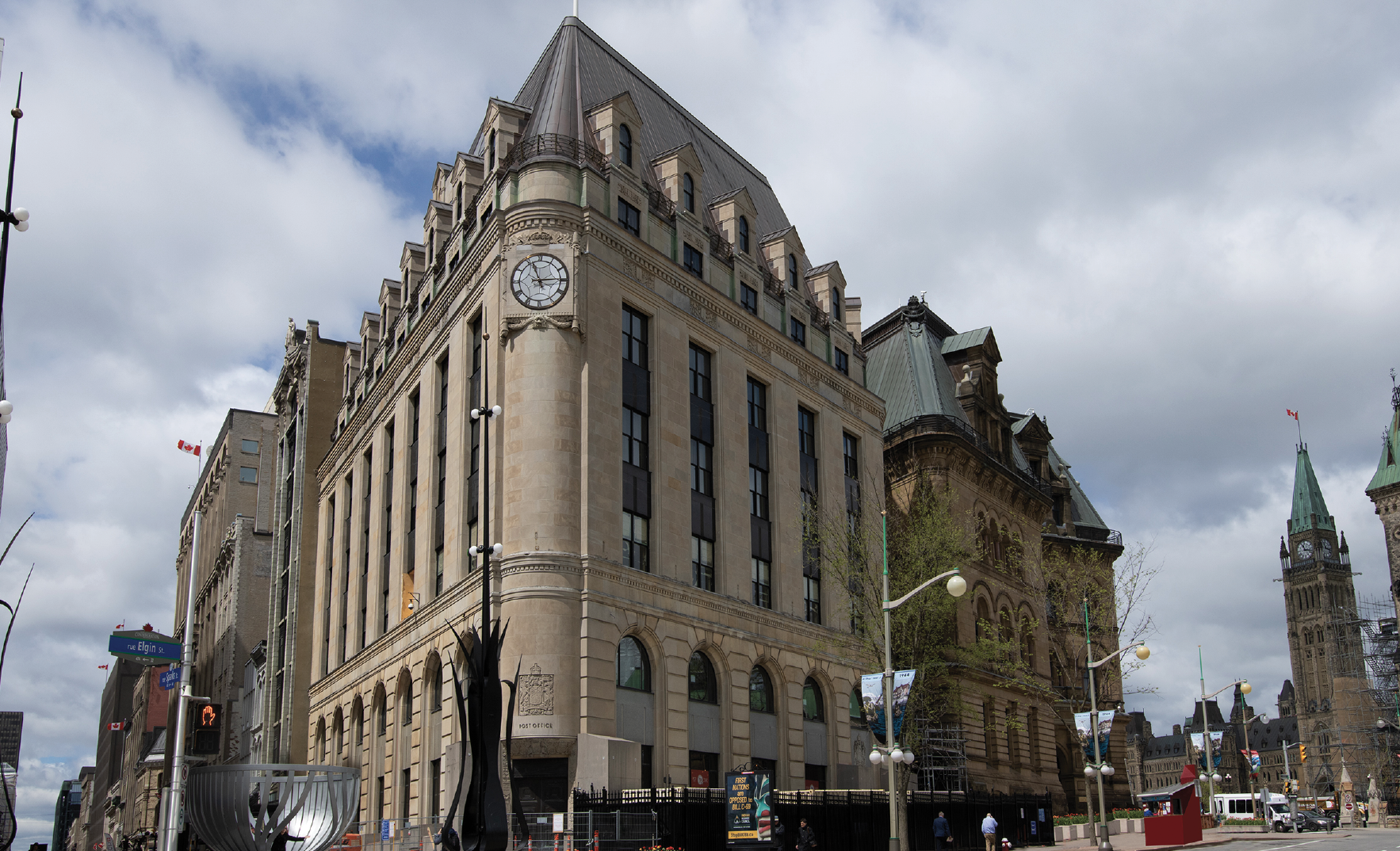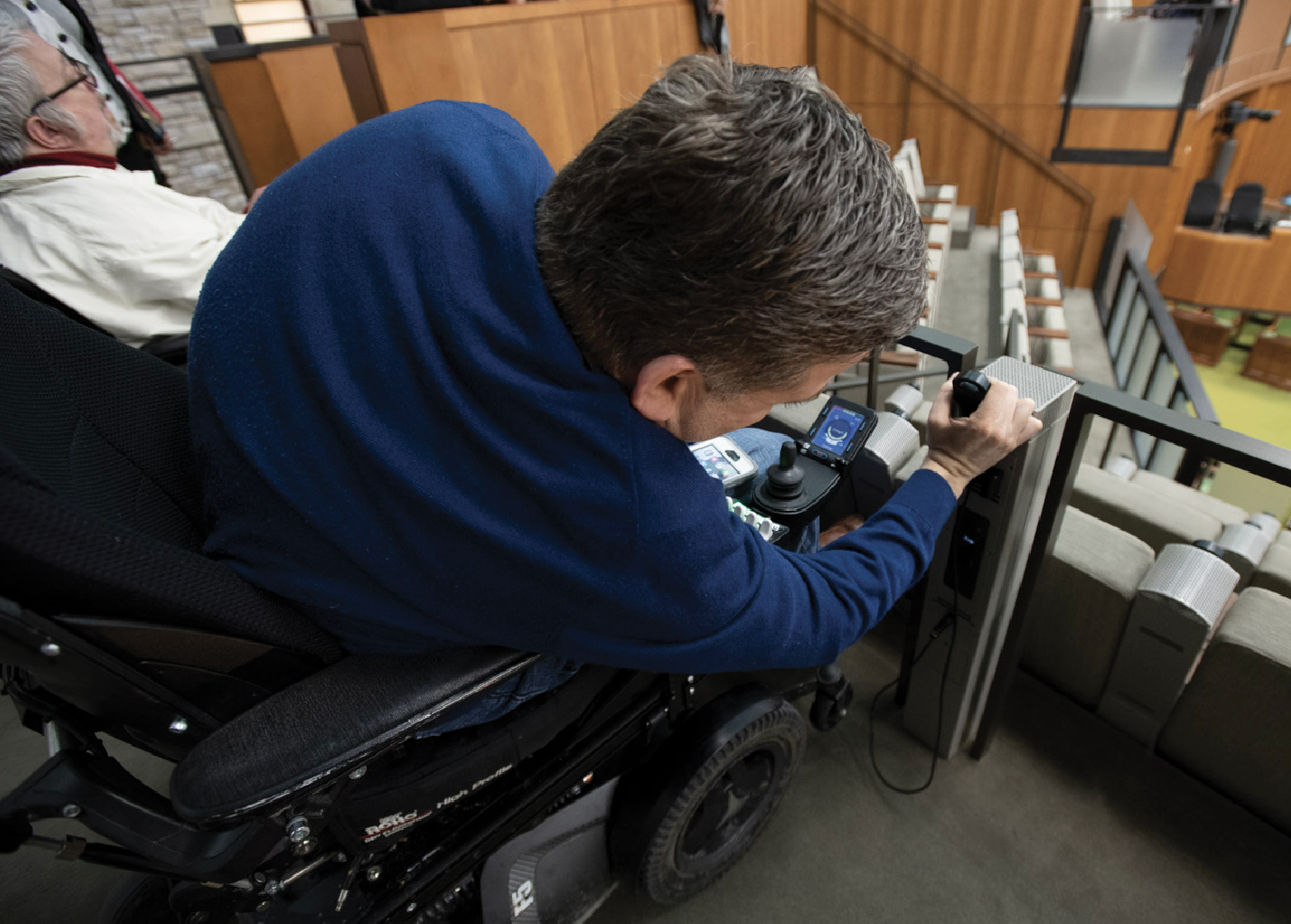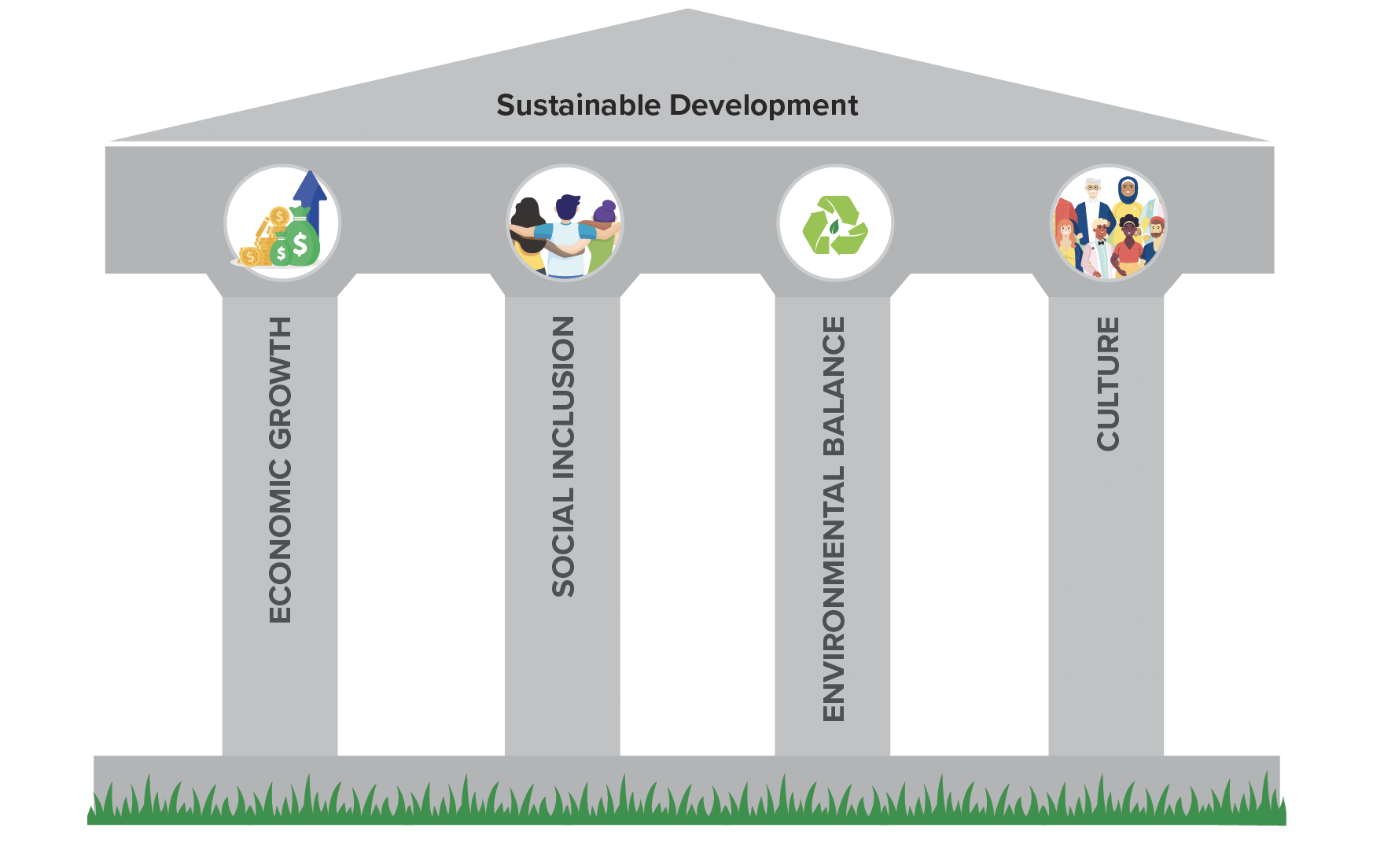Delivering results for Canadians: The Long Term Vision and Plan for the Parliamentary Precinct—Annual Report 2018 to 2019
On this page
Accessibility in the precinct

The grounds and buildings throughout the Parliamentary Precinct were designed and built over 100 years ago, long before accessibility standards were in place. This reality poses unique challenges with regards to the need to balance modern accessibility requirements with the preservation of heritage character. New and restored buildings throughout the precinct, including the West Block, Senate of Canada Building, and phase 1 of the Visitor Welcome Centre, have been designed and built to overcome these challenges and to meet and in, many cases, exceed building codes.
In accordance with Bill C-81 “The Accessible Canada Act”, Public Services and Procurement Canada (PSPC) is exceeding accessibility standards throughout its rehabilitation of the Parliamentary Precinct. PSPC is becoming a leader and model in the development of accessible environments by making the precinct more family friendly, inclusive, and open to the public. This commitment presents an opportunity in the development of the Campus Master Plan, whereby the integrated campus approach will continue to enhance accessibility across the entire precinct.
The rehabilitation of the Centre Block and redevelopment of Blocks 1, 2, and 3 will further allow PSPC to showcase global leadership in universal accessibility within a heritage context. PSPC’s design team is collaborating with all stakeholders to create a balance between accessibility, security, heritage, and existing site conditions, to position the precinct as a model of accessibility for generations to come.
Accessible Parliament
To promote a more open Parliament that is accessible to all Canadians, rehabilitated buildings have been modified to include enhanced broadcast capabilities and simultaneous translation for other languages, including Indigenous languages.
Universal Accessibility Review and Action Plan
In 2018 to 2019, PSPC conducted an Accessibility Review in order to develop an action plan. The purpose of this study was to develop the strategy, criteria, tools, and plan for the Parliamentary Precinct to make the grounds and buildings universally accessible.

Postal Station B at the corner of Sparks and Elgin streets.
Postal Station B upgrades
As part of the planning to renovate the Postal Station B building, members from the Accessibility Advisory Panel have been engaged to improve accessibility in the multipurpose boardroom. Input and recommendations will be implemented in the final design based on these discussions.

As part of our Accessibility Review, participants with disabilities were invited to provide feedback on the accessibility features of the West Block.
Exploring technologies: pilot projects
Project Design Teams are exploring the use of innovative technology within Parliamentary buildings to improve wayfinding for those who are blind, have low sight, or have cognitive challenges. Technologies being considered and piloted include: beacon technology, tactile mapping, sight enhancing goggles, and retractable chair lifts.
An Accessibility Advisory Panel was established to provide advice and direction to the development of the Universal Accessibility Review and Action Plan (UARAP). The Panel is composed of key stakeholders, including the Parliamentary partners, the Treasury Board Secretariat, the National Capital Commission (NCC), the Department of Canadian Heritage, accessibility organizations (such as Canadian National Institute for the Blind (CNIB), Rick Hansen Foundation, March of Dimes Canada, Canadian Deaf Association, Communication Disabilities Access Canada, Canadian Hard at Hearing Association, and Spinal Cord Injury Canada), and employees representing various communities (persons with mobility challenges, blind or low vision, deaf or hard of hearing, sensory/cognitive challenges).
Accessibility working group members' testimonials
A sub-group of the Accessibility Advisory Panel was asked to informally evaluate the newly completed West Block, Visitor Welcome Centre and Senate of Canada buildings to assess how accessible the new buildings were. The following quotes were received from individuals who have accessibility challenges (mobility, sight and hearing) upon their completion of tours of the newly rehabilitated buildings:
“I am amazed of the immense talent of those who managed to preserve original structures while incorporating soundproofing and other 21st century technology.”
“As I first entered the building through the Visitors Welcome Centre, I immediately was impressed by the character of the complex, the high ceilings and the broad hallways all conveyed this feeling of being in a historical yet modern and functional environment.”
“The paths of travel have included accessibility elements and make it easy to get around”
The path forward - Accessibility in the Precinct
The achievements of completed projects have allowed the Parliamentary Precinct to become a model for accessibility with the site and buildings more accessible, family-friendly and open to the public. As PSPC advances the development of the integrated parliamentary campus, accessibility will continue to be a key component of the LTVP update. Next steps include:
- moving forward on the UARAP by working with the consultant and Advisory Panel
- continuing to make immediate accessibility improvements to the existing buildings and grounds
- exploring the latest technologies and accessibility features, while continuing to actively engage with internal and external stakeholders
Sustainability in the precinct

PSPC has committed to showcasing the precinct as a model of sustainability through the modernization of the precinct’s buildings and grounds. The department has taken steps towards establishing the precinct as an eco-campus, leveraging the buildings in the precinct to adopt a campus-wide approach to sustainability.
The 4 pillars of sustainable development

Image description of the four pillars of sustainable development
This image depicts the 4 pillars of sustainable development that PSPC considers when implementing and developing the Long Term Vision and Plan. They are: economic growth, social inclusion, environmental balance and a cultural dimension.
Sustainable development is a concept that was originally based on three pillars: economic growth, social inclusion, and environmental balance. A fourth pillar has emerged, reflecting the importance of the cultural dimension in sustainable development. This cultural pillar is particularly relevant to the Parliamentary Precinct as it acknowledges the importance of Indigenous cultures and traditions, heritage considerations, and cultural creativity in developing sustainable public policies and building sustainable communities.
Sustainability targets are built into every LTVP project and are often exceeded, as demonstrated by the achievement of numerous Green Globe Certifications. This certification is an eco-rating program that acknowledges sustainability efforts and was developed in 2000 with the support of the Government of Canada. Completed projects in the precinct have met or exceeded these standards, including these three major heritage rehabilitation projects completed since 2015:
- Sir John A. Macdonald Building—5 Green Globes
- 180 Wellington—4 Green Globes
- Postal Station B—3 Green Globes
Environmental Sustainability Strategy and Action Plan
In 2018 to 2019, PSPC launched an Environmental Sustainability Strategy and Action Plan for the Parliamentary Precinct, which will be implemented from 2019 to 2022. This 3-year strategy is a planning tool that sets out sustainable development priorities, establishes goals and targets, and identifies actions to achieve them. The strategy aligns with the Federal Sustainable Development Strategy (2019 to 2022), and responds to the unique characteristics of the precinct and its context within the National Capital Region, with particular focus on water conservation, waste, and energy.
2018 to 2019 progress
- In 2018 to 2019, PSPC achieved other sustainability milestones, including:
- Achieved a 56% reduction in greenhouse gas (GHG) emissions from a 2005 to 2006 baseline, as a result of 4 key factors:
- rehabilitating and upgrading precinct assets
- operational upgrades of assets
- a cleaner Ontario electrical grid
- as part of Energy Services Acquisitions Program (ESAP), switching from natural gas-fired steam chillers to electric chillers for district cooling
- Increased the number of electrical vehicle charging stations for plug-in hybrid electric vehicles and electric vehicles in the precinct
- Launched a Climate Change Vulnerability Assessment to understand the effects of extreme weather events on the infrastructure within the precinct
- the results of the study will provide engineering and operational recommendations to increase the portfolio’s resilience to climate change
- Collaborated with Natural Resources Canada and the National Research Council to develop the Sustainable Design Principles for new construction projects in the Parliamentary Precinct
Sustainability results in the precinct
Major projects target a 25% reduction in energy consumption over and above the National Energy Code, and all heritage rehabilitation projects in the precinct target ratings of 3 Green Globes
The Department is on track for a GHG emissions reduction of 80% by 2030 and carbon neutrality by 2050. PSPC also diverts over 90% of demolition materials from landfills. The final waste diversion rate for both the West Block and the Senate of Canada building is 93%.
Energy efficient measures include:
- building envelope improvements
- heat capture and reuse
- and solar hot water panels
In addition to recycling over 90% of demolition materials from all major projects (exceeding the 80% target), other environmental sustainability measures include the implementation of water-saving plumbing systems, rain water harvesting, the installation of beehives on the East Side of the Senate of Canada Building, and green walls within renovated buildings.
The path forward - Sustainability in the Precinct
During the years to come, PSPC will focus on the following:
- reducing GHG emissions by 80% by 2030 (compared to 2005 to 2006 baseline emissions) and 100% by 2050
- ensuring that the precinct remains protected from and resilient to expected changes in the climate
- managing the precinct’s lands and buildings to positively impact local ecology, human health, and visitor experience
- integrating environmental sustainability considerations into all levels of planning, design, and decision-making within PSPC
In order to achieve a target of 80% reduction in GHG emissions in the precinct by 2030, PSPC will undertake the following initiatives:
- the implementation of the ESAP
- the continued transition to clean electricity
- the ongoing implementation of energy improvements as part of major rehabilitation project
To reduce the GHG emissions of completed major capital projects, PSPC has developed a GHG Options Analysis methodology. This is a holistic approach that examines buildings as complete systems, while considering the interaction of different elements, such as mechanical systems, lighting, people, equipment loads, and the external environment. It will examine to further reduce GHG emissions and increase energy self-sufficiency. This is being undertaken in the development of the Centre Block and Block 2 projects to explore efficient and cost-effective sustainability options that reduce environmental impacts. Achieving high standards of sustainability, while balancing costs and preserving cultural heritage, will ensure that Parliament and surrounding areas can be enjoyed and experienced by Parliamentarians and generations of Canadians to come.
Our people at work

Innovation and youth
PSPC offers people of different ages, genders, ethnicities, and perspectives the opportunity to contribute to Canada’s history through the historic projects delivered by the LTVP.
By establishing partnerships with Canadian post-secondary institutions, such as the University of Alberta, the University of Calgary, Carleton University, the University of Manitoba, and the University of Montreal, PSPC has leveraged unique research capacity and leading-edge expertise towards the delivery of the LTVP. These partnerships also provide invaluable job experience for Canadian youth, creating opportunities for many students to hone the skills and practical experience they need to succeed, while contributing to the historic work within the precinct.
As a result of these partnerships, PSPC is now using 3D imaging to improve the design, construction, and operations of the Parliament Buildings; and is using technology, such as 3D printing and robotic stone cutting, to restore them. PSPC is also working with the University of Guelph to propagate the American Elm Tree (previously located in the Pleasure Grounds on Parliament Hill) by providing genetic samples to support the University’s Elm Recovery Project. Once competed, these measures will enable this historic Parliamentary Precinct tree to continue to live on in Canada.
Masonry apprenticeships
The LTVP provided the opportunity to run a masonry apprenticeship program that had over 60 participants, 30% of which were women. This is the highest ever recorded total for a program of this nature in North America.
Innovation
PSPC is conducting a research project to investigate best practices to improve the thermal energy performance of heritage buildings. This innovative research is being conducted in partnership with government, academic, and private-sector partners with extensive experience in Canada and abroad, to use the Parliamentary Precinct as a “living laboratory”. This will be leveraged to evaluate the performance of various interventions that have been used in the rehabilitation of the precinct’s heritage buildings to date.
The goal is to understand the effectiveness of different approaches and their implications for heritage structures. This analysis will lead to best practices that will inform future rehabilitations, not only in the Parliamentary Precinct, but elsewhere in Canada and beyond where important heritage buildings are being rehabilitated to be more sustainable and energy efficient.
Job creation and Indigenous partnerships

In addition to the thousands of jobs the LTVP has generated to date through recently completed major projects, PSPC encourages its contractors to demonstrate a fair representation of the Canadian population, including youth, women, and Indigenous people.
PSPC continues to leverage the LTVP to increase the number of meaningful economic opportunities for Indigenous businesses, employment, and capacity building. Substantial expenditures for major projects are tendered to and through Indigenous firms. PSPC has awarded over $40 million in work for Indigenous firms since 2007 to 2008 on projects within the scope of the Parliamentary Precinct. PSPC has also committed to include provisions in all of our major projects’ contracts that would subcontract at least 5% of work to Indigenous firms.
All recently completed major projects have included the use of set-asides, providing for:
- a range of goods, including artisanal millwork and furniture for the parliamentary offices, the new Cabinet Room in the West Block, and committee rooms
- an array of services such as Environmental Engineering Services for the completed Wellington Building and for future Project Management Support Services and Construction Management Services for the entire Parliamentary Precinct
Outreach and partnerships
As a historic program located in the heart of Canada, the implementation of the LTVP is a unique opportunity to engage and partner with a wide variety of organizations and institutions both at home and abroad.
PSPC collaborates closely with Parliamentary partners and stakeholders, such as the City of Ottawa, the National Capital Commission, and the Federal Heritage Buildings Review Office to shape the precinct into a modern, accessible, sustainable, and secure parliamentary Campus.
A new plan for Sparks Street
PSPC has partnered with the City of Ottawa and the National Capital Commission on the Sparks Street Public Realm Study, including providing a temporary pop-up space for public consultation at 79 Sparks Street.
The Study will provide direction for street functions, streetscape themes, and design elements within the public-right-of-way to renew Sparks Street. This also coincides with PSPC’s update to the LTVP for the Parliamentary Precinct (including Blocks 1, 2, and 3 on Sparks Street).
Ongoing public engagement is underway with residents, business owners, landowners, surrounding community associations, and government agencies to establish the future use of the iconic Sparks Street pedestrian mall through improved operation.
About the Sparks Street pedestrian mall
As Canada’s first outdoor pedestrian mall, Sparks Street is an iconic gathering space in the heart of Ottawa’s downtown. Since 1967, residents and visitors have gathered to shop, dine, and enjoy festivals of all kinds.
Partnerships
PSPC has built relationships with key organizations, both in Canada and abroad, to share best practices on the preservation and rehabilitation of heritage assets. Through these relationships, PSPC aims to promote innovation, encourage collaboration, knowledge sharing, and facilitate the adoption of lessons learned, while showcasing its world-class experience and accomplishments.
Over the past year, PSPC hosted visits from the Architect of the Capitol of the United States, as well as from the Young Employees Association of the Dutch Ministry of the Interior and Kingdom Relations, allowing PSPC to develop innovative collaboration opportunities on a global scale.
The International Network of Parliamentary Properties
PSPC chairs and is a founding member of the International Network of Parliamentary Properties (INPP), a forum for the exchange of knowledge, lessons learned, and best practices with a global community of professionals from 15 member countries that share a common mandate and have expertise in the operation, restoration, and rehabilitation of Parliamentary real property assets. Activities with the INPP include the trip to Vienna in November 2018, for their Annual Conference, in which representatives from PSPC and the House of Commons participated in meetings with the United Nations Strategic Heritage Plan Program Office (UNSHPPO). PSPC also held meetings with other members of the INPP include representatives from the European Parliament, Italy, the United Kingdom, and Switzerland, among others. In 2020, Canada will host the INPP Annual Conference.
As Chair of the INPP Steering Committee, PSPC also developed the 2019 to 2020 INPP program of work which included:
- Leading a sustainability benchmarking exercise
- Initiating an Architecture community of practice
- Providing an on-line forum for the exchange of ideas pertaining to current practices and innovative approaches in the field of heritage renewal